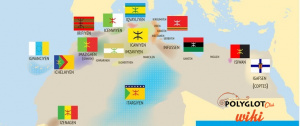Language/Kabyle/Grammar/Alphabet-and-pronunciation
In this lesson, we will learn the Kabyle alphabet and its pronunciation rules, including vowels, consonants, special characters, and some cultural information about the Kabyle language.
Introduction
Kabyle is a Berber language spoken primarily in northern Algeria, especially in the Kabylie region. With over 6 million speakers, it is the second most spoken Amazigh language after Shilha (or Tashelhit) in Morocco. Kabyle uses the Latin alphabet with the addition of some special characters, and it is written from left to right, just like English.
Vowels
Kabyle has three basic vowels, which are similar to most other Berber languages. These vowels are /a/, /i/, and /u/.
| Kabyle | Pronunciation (IPA) | English Equivalent |
|---|---|---|
| a | /a/ | like 'a' in 'cat' |
| i | /i/ | like 'ee' in 'see' |
| u | /u/ | like 'oo' in 'boot' |
Consonants
Kabyle has many consonants, some of which have no equivalent in English. The pronunciation details of each consonant are given below, along with English equivalents or approximate sounds.
| Kabyle | Pronunciation (IPA) | English Equivalent |
|---|---|---|
| b | /b/ | like 'b' in 'bat' |
| c | /ʃ/ | like 'sh' in 'shoe' |
| d | /d/ | like 'd' in 'dog' |
| ḍ | /ɖ/ | like 'd' in 'adore' but more retroflex |
| f | /f/ | like 'f' in 'fish' |
| g | /ɡ/ | like 'g' in 'go' |
| ǧ | /ʒ/ | like 's' in 'treasure' |
| h | /h/ | like 'h' in 'hello' |
| k | /k/ | like 'c' in 'cat' |
| l | /l/ | like 'l' in 'look' |
| m | /m/ | like 'm' in 'may' |
| n | /n/ | like 'n' in 'no' |
| ɳ | /ɳ/ | like 'n' but with the tip of the tongue curled back |
| p | /p/ | like 'p' in 'pat' |
| q | /q/ | like 'k' but produced further back in the throat |
| r | /r/ | like 'r' in Spanish 'perro' |
| ṛ | /ɽ/ | similar to 'r' in American English 'butter' |
| s | /s/ | like 's' in 'say' |
| ṣ | /s' | an emphatic version of the 's' |
| t | /t/ | like 't' in 'tap' |
| ṭ | /ʈ/ | like 't' in 'star' but more retroflex |
| v | /v/ | like 'v' in 'vase' |
| w | /w/ | like 'w' in 'way' |
| x | /x/ | like 'ch' in German 'Bach' |
| y | /j/ | like 'y' in 'yes' |
| z | /z/ | like 'z' in 'zoo' |
| ẓ | /z'/ | an emphatic version of the 'z' |
Special characters
Kabyle has some special characters, such as vowels with diacritics and a few modified consonants.
| Kabyle | Pronunciation (IPA) | English Equivalent |
|---|---|---|
| ä | /æ/ | like 'a' in 'bath' |
| ë | /ə/ | like 'e' in 'the' |
| î | /iː/ | similar to 'ee' in 'see', but longer |
| ô | /o/ | like 'o' in 'go' |
| ü | /y/ | like 'ü' in German 'fühlen' |
| ġ | /ɣ/ | like a voiced version of 'ch' in German 'Bach' |
| x̣ | /χ/ | like 'ch' in Scottish 'loch' but more guttural |
Syllable structure and stress
Syllables in Kabyle usually take the form of a consonant followed by a vowel (CV) or a consonant followed by a vowel and another consonant (CVC). Exceptions occur in some borrowed words from other languages. Stress usually falls on the penultimate syllable (the second-to-last syllable) of a word. In words with only one syllable, no stress is applied.
Cultural information and interesting facts
Kabyle is the native language of the famous singer and songwriter, Idir. He is known for mixing Kabyle, French, and English lyrics in his songs. This crossover style of music has also influenced many other artists who incorporate Kabyle into their music.
Kabyle has been the subject of a robust linguistic revival in recent years, particularly in Algeria. As a result, there is a growing number of educational resources available for learning the language, including books, online courses, and language apps. This surge in language resources contributes to the preservation and promotion of Kabyle as a living language within the diverse community of Berber speakers in North Africa.
In the Kabylie region, Kabyle is used in various types of media, including newspapers, radio, and television. This has allowed the language to maintain its cultural significance and to continue evolving to meet the needs of the modern world. The current vitality of Kabyle is a testament to the resilience and adaptability of the language and the people who speak it.

